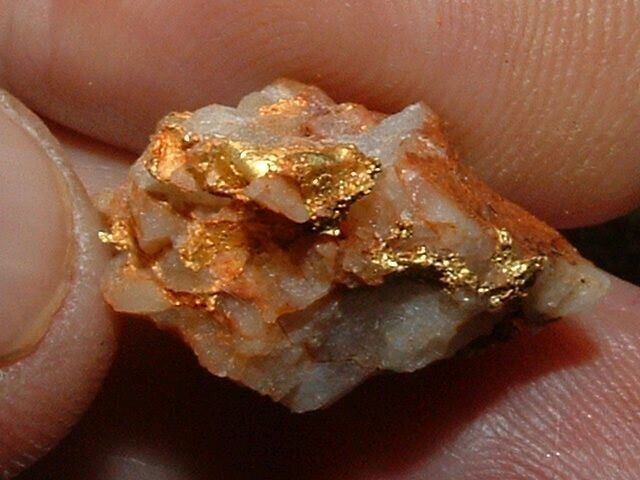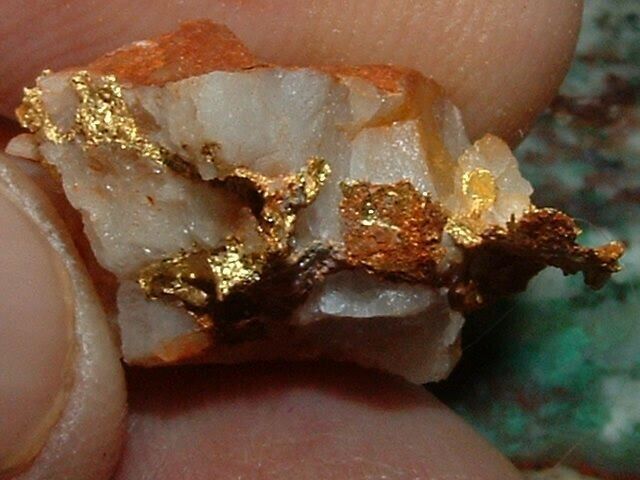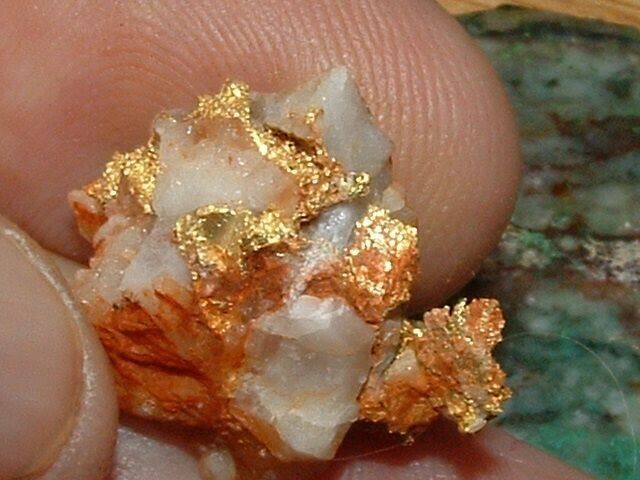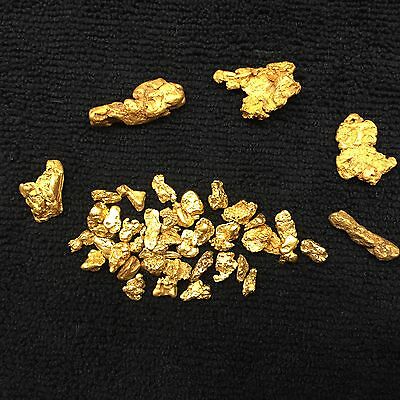-40%
CALIFORNIA LEAF GOLD QUARTZ SPECIMEN 5.89 GRAM
$ 126.71
- Description
- Size Guide
Description
NATIVE GOLD QUARTZ SPECIMENfrom the
MOTHER LODE
R
uler is
1/4"
wide (6 mm). U.S. 10 cent coin is 17 mm in diameter.
S
pecimen weight:
5.89
G
ram -
91
G
rains (Troy)
S
ize:
24X19.8X11.4
mm long
If you like gold straight from the earth, stick around. Here's a great specimen of epithermal zone rock beaming with pristine crystalline gold leaf. What looks almost like dried blood is oxidation stain. There's a big difference between your average leaverite and a genuine gold quartz specimen. I sell authentic GOLD specimens, gold nuggets, and gold quartz cabs. It burns me to see so many rocks containing no visible gold listed in this category.
As found in nature, silicate rock is generally part of the gold/specimen equation. Here, we have
oxidized
quartz hosting the gold. The sizable exposures of leaf gold really pop. If you're a detectorist, e
xpect a resounding 'Zip!' on your machine. For bullion hunters shopping super bargains, it's a bad investment, but for those who appreciate legendary gold in
its
most raw, natural state, this one's a prize find. One can only imagine how the 49ers reacted the first time they saw gold in their pans and sluices. The authenticity of this California gold specimen is guaranteed.
It takes a lot of effort to find gold whether it's placer, pocket, or high-grade lode. From my perspective, having spent so many years on the hunt for wild gold, there's really no such thing as an 'ugly nugget' or specimen. Each one is beautiful in it's own way. I guarantee the gold growths here are a natural occurrence.
All my specimens show visible gold and are
authentic
gold quartz specimens.
I don't paste 'pounded gold' or spray gold-colored paint on barren rock. Refractory ores, which need to be heated and run through special processes to release the minute amount of gold locked up inside, aren't usually my thing. When I do sell sulphides, you'll be able to see gold associated with the pyrites. You won't need to crush and treat my rocks with cyanide solution to dissolve the gold thereby allowing it's recovery. We're not dealing in micron oro. I deal in genuine high-grade, naturally-occurring gold quartz with visible gold, both as specimen and as jewelry-grade slab. Such rich rocks and lapidary rough are hard to find and expensive to obtain.
U.S. SHIPPING - .00
(includes USPS tracking and insurance to all U.S. destinations)(shipped via priority box)
INTERNATIONAL CUSTOMERS - S&H .00
FAST REFUND OFFERED
(If, for any reason, you're not happy with this item)
I poured through old mining dumps for years looking at orange-yellow-rusty rock through a loupe, but I never found a piece with visible gold.
Hydrothermal solutions carrying gold and silica crystallized into veins of gold quartz. This specimen comes from one of the many vein systems sourcing the immense placer deposits of the Sierra Nevada Mtns, the famed Mother Lode.
Weight Conversions:
15.43 GRAINS = 1 GRAM
31.103 GRAMS = 1 TROY OUNCE
24 GRAINS = 1 PENNYWEIGHT (DWT)
20 DWT = 1 TROY OUNCE
480 GRAINS = 1 TROY OUNCE
S & H
Discounted for combined shipments.
U.S. BUYERS
S & H .00 (via USPS to all U.S. destinations)
ATTN: INTERNATIONAL BIDDERS
INTNL. BUYERS - .00 via USPS Priority box.
On higher valued items, shipping via USPS Priority Mail International or Express is recommended.
See USPS International shipping calculations.
PAYMENTS
For U.S. buyers: We accept paypal
For intnl. customers: We accept paypal.
Pay securely with
www.paypal
.
Payment must be made within 7 days from close of auction. We ship as soon as funds clear. If you have questions, please ask them before bidding.
REFUNDS
We leave no stones un-turned insuring our customers get what they bargained for.
If you're not satisfied with this item, contact me. Then, if the problem can't be fixed, return product within 30 days in 'as purchased' condition for a full refund
PROSPECTING IN TRINITY COUNTY
Back around 1980, shortly after gold had risen to 00 an ounce, she began a rather rapid descent. Despite gold's volatility, Trinity County crawled with prospectors hoping spot would go back up. All of us watched the market diligently trying to time our gold sales with her upswings. I worked the Shasta-Trinity Alps for four seasons, met a lot of terrific folks, had a blast, and lived to tell the tale. With large suction dredges operating all up and down the river, each day dawned on a brand new adventure. Initially, the prospect of working with 30 feet of water over your head didn't seem all so appealing, but once the early jitters had worn off, the thought of working that deep became almost intoxicating. Fortunately, the waters of the Trinity were clear as a bell. This exceptional visibility helped alleviate some of the anxieties. Of course, if other dredges were operating directly upstream from you, the water tended to be a tad murky. After short-lived stints working with different crews,
I decided to build a few gold-sucking contraptions myself. Any half-serious gold miner is eventually going to want equipment he can call his own, so naturally, it wasn't long before I had my own fleet.
Watching documentaries of small-scale gold miners working in miserable conditions around the world, I pity the poor South American, Filipino, and African gold-dredging community. One tries to imagine what it must be like forced to work in some muddy abyss with zero visibility only an ordinary air-hose clamped between one's teeth. No mask, no regulator, just sheer grit and want to enough to bite down on a rubber hose carrying breathable air. That, dude, is some crazy, scary stuff.
But along the Trinity, no one resorted to such extreme methods. We were a fairly modern collective of miners. ha. W
hen not dredging, I reverted to more-traditional, small scale, hand-mining methods like sluicing, panning, high-banking, detecting, and dry-washing. Talk about hi-tech. A small dip box proved a most effective tool for testing bank run gravels and, of course, no prospector ventures anywhere without his gold pan. Detectors, as well, can be worth their weight in gold. Dredge owners and operators, running every kind and make of suction dredge imaginable had staked up about 20 miles of river. Everyone joined the search for a rich pay-streak. Mining encampments proliferated. Out on a prospecting jaunt, it wasn't uncommon to stumble on a makeshift hootch anywhere out in the woods. Many of the old hydraulic cuts were inhabited by diggers trying to survive cheaply scraping out a little beer and tobacco money from the worked-over ground. This was a social dynamic not unlike that which existed a hundred years earlier. Judging from the TV reality shows, one might think this segment of the mining community was comprised mostly of misfits, guys on the lam, sociopaths, and growers, but back then was a different era and culture than it is today. Out in the bush, off the grid, there was a lot less hostility to be found back in the 1980s. Local 'woodsies' were mostly honest, genial fellows. Some guys simply preferred to live within their means up in the hills away from society's high cost of living and condescending attitudes.
Thanks for checking out our digs.
G
old of
E
ldorado
1-14-13
















